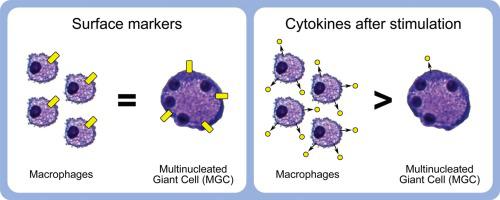Immunobiology ( IF 2.5 ) Pub Date : 2020-05-05 , DOI: 10.1016/j.imbio.2020.151952 Kevin L Trout 1 , Andrij Holian 1

|
Macrophages fuse into multinucleated giant cells (MGC) in many pathological conditions. Despite MGC correlations with granulomas, their functional contribution to inflammation is relatively unknown. An in vitro mouse model of IL-4-induced bone marrow-derived macrophage fusion and microfiltration were used to generate enriched MGC and macrophage populations. Phenotypes were compared in response to well-known inflammatory stimuli, including lipopolysaccharide and crocidolite asbestos. Surface markers were assessed by flow cytometry: CD11b, CD11c, F4/80, and MHC II. Secreted cytokines were assessed by multiplex immunoassay: IFN-γ, IL-1β, IL-6, TNF-α, IL-10, IL-13, and IL-33. Results show that MGC maintained macrophage surface protein expression but lost the ability to produce a cytokine response. This suggests a potentially beneficial role of MGC in isolating the host from a foreign body without contributing to excessive inflammation. This study and future research using other stimulants and environments are important to gaining a fundamental MGC cell biology understanding. This will inform approaches to controlling the foreign body response to particle exposure, medical implants, and many diseases associated with granulomas.
中文翻译:

响应刺激的多核巨细胞表型。
在许多病理条件下,巨噬细胞融合成多核巨细胞 (MGC)。尽管 MGC 与肉芽肿相关,但它们对炎症的功能贡献相对未知。一个我ñ体外IL-4 诱导的骨髓源性巨噬细胞融合和微滤的小鼠模型用于产生富集的 MGC 和巨噬细胞群。比较表型以响应众所周知的炎症刺激,包括脂多糖和青石棉石棉。通过流式细胞术评估表面标志物:CD11b、CD11c、F4/80 和 MHC II。通过多重免疫测定评估分泌的细胞因子:IFN-γ、IL-1β、IL-6、TNF-α、IL-10、IL-13 和 IL-33。结果显示MGC维持巨噬细胞表面蛋白表达但失去产生细胞因子反应的能力。这表明 MGC 在将宿主与异物隔离而不导致过度炎症方面具有潜在的有益作用。这项研究和未来使用其他兴奋剂和环境的研究对于获得基本的 MGC 细胞生物学理解很重要。这将为控制对颗粒暴露、医疗植入物和许多与肉芽肿相关的疾病的异物反应提供信息。











































 京公网安备 11010802027423号
京公网安备 11010802027423号